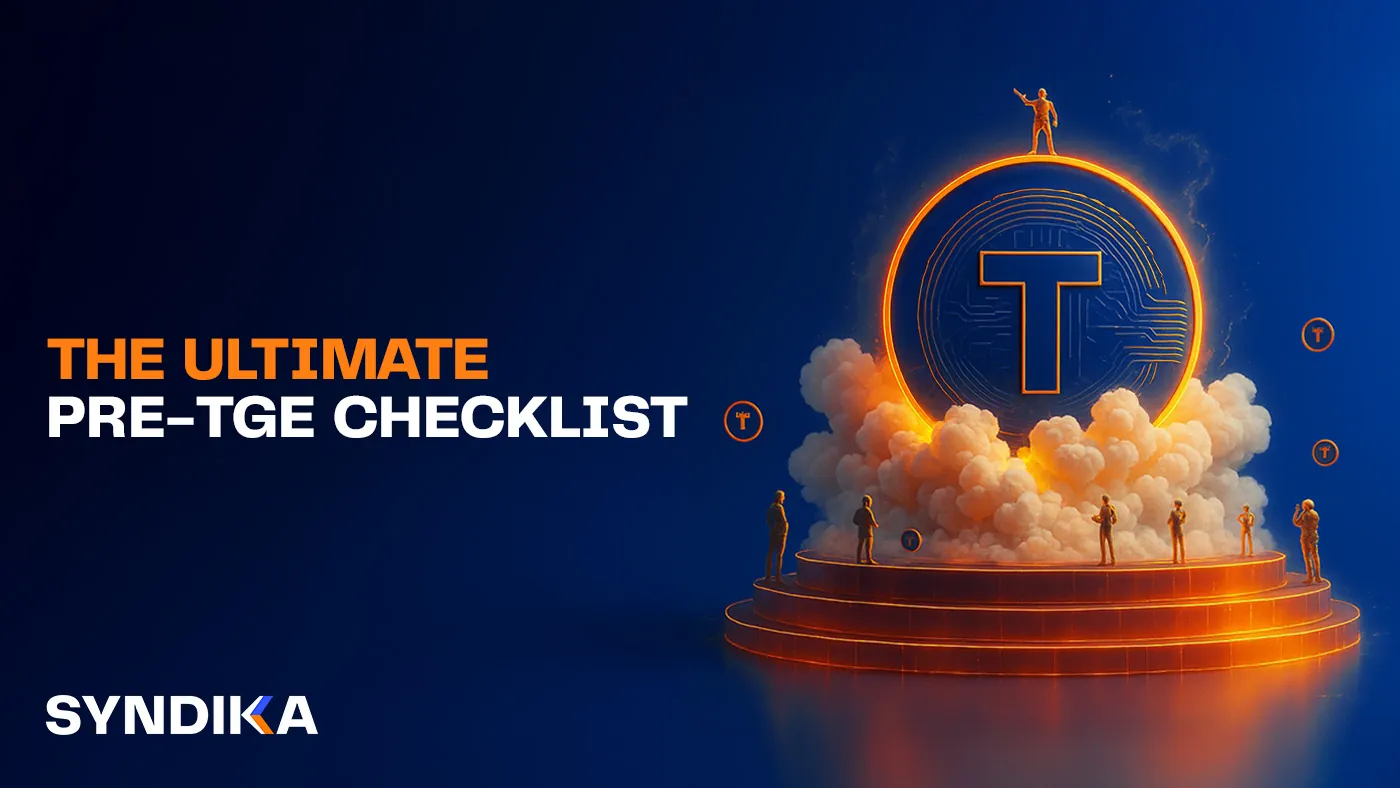
Let’s assume you’ve already done the hard part:
✅ You’ve built a working product (MVP)
✅ Your tokenomics model is solid and validated
✅ You’ve defined clear token utilities that align with your user journey (Check out this article to learn the most common tokenomics mistakes).
Now comes the next critical phase: preparing for your Token Generation Event (TGE).
Q1 of 2025 alone saw the collapse of 1.8 million tokens, which makes almost half of all recorded Web3 startup failures of that period.
These statistics underscore the importance of thorough pre-TGE planning. In a Web3 ecosystem, rushed token launches without a solid foundation often lead to poor user engagement, liquidity issues, and, as a result, rapid devaluation.
In collaboration with our partners and Members, Syndika has prepared a full checklist that will help your blockchain project avoid costly mistakes and align your token launch with long-term success, not just day-one hype.
1. Stay in the Loop of Market Conditions
In crypto, timing matters. A token launch in a bearish market or during a wave of major competitor TGEs can stall even the most promising projects.
Before setting your TGE date:
- Analyze how recent token launches are performing
- Monitor the crypto market’s ups and downs
- Avoid overlapping with major protocol upgrades or competitor launches
You only get one shot at a first impression—launch into strength, not silence.
2. Define Success Metrics Before Launch
If you don’t define success before your TGE, you’ll end up chasing noise after it.
Set pre-aligned KPIs like:
- On-chain DAUs or active wallets
- Token holder distribution and retention
- TVL targets and LP participation
- Governance participation or staking ratios
- Treasury utilization rate
These metrics will shape your emissions strategy, market maker performance expectations, and post-launch narratives.
3. Follow a Strategic Token Listing Flow
Don’t list just because it feels like the next step. Use a structured decision framework (like Enflux’s Listing Decision Tree) to assess:
– Do you have active users?
– Is the listing fee <5% of treasury?
– Can you afford liquidity lockup without harming operations?
– Will you have 6+ months of runway after listing?
– Will the exchange bring in new users?
If any answers are “no,” you’re likely better off postponing your coin listing.
4. Coordinate the Chaos: GTM Across CEXs, DEXs, Launchpads
You need a coordinated go-to-market (GTM) plan to ensure your token launch is synchronized across platforms and stakeholders.
This includes:
- Launchpad timeline alignment
- Liquidity provisioning plans for DEXs and CEXs
- Market maker coordination and terms
- Token distribution sequencing (private, public, strategic)
“For Web3 startups, navigating liquidity, market makers, launchpads, CEX listing, and DEXs can be complex—everyone involved usually has their own agenda. Best to have these people talking to one another and come up with a coherent GTM plan or get someone to manage these conversations that knows how all these players should fit together for a good launch to take place, ” confirms Adam, Head of BD at ApeBond.
5. Negotiate CEX Terms Early and Intelligently
Too many Web3 founders accept poor exchange terms at the last minute, leading to misaligned incentives and rushed launches.
Start early:
- Discuss listing timelines, token allocation expectations, and marketing support well in advance
- Vet listing fees and liquidity requirements across multiple venues
- Protect your community from predatory CEX behavior (such as holding user allocations hostage or excessive vesting control)
The goal isn’t just getting listed—it’s getting listed on your terms, with partners who align with your long-term success.
6. Prepare Investors with Clear, Trust-Building Materials
Your early investors will be your loudest supporters—or your biggest source of post-launch pressure. As Gasper Stih, CMO at Klink Finance, says, you should be “prepared with the right partners to support you across liquidity, growth, and operations.”
Set them up for alignment. Before TGE, prepare:
- A token primer that explains mechanics, utilities, and long-term goals
- A tokenomics breakdown that clearly defines supply, emissions, and unlocks
- A TGE strategy + roadmap outlining what to expect at launch and in the weeks after
- FAQs to anticipate investor concerns (liquidity, governance, price dynamics)
Make it easy for investors to advocate for you, not question you.
7. Plan Community Activities
“Many early-stage projects pour hundreds of thousands of dollars into listings and partnerships, only to launch into silence. Without an engaged user base, trading volume stalls, and retention drops. Worse, reliance on short-term incentives or bribes attracts mercenary users who vanish after claiming their rewards, ” says Boba, Senior Business Developer from ApeBond.
Lorenzo Coni, Head of Business Development at Sweat Economy, adds: “It’s not about inflating numbers with last-minute airdrop hunters—it’s about cultivating long-term believers who will engage beyond the TGE. Even if your community isn’t massive, authenticity and alignment matter more than scale.”
Invest your energy in building and activating a real community. Here’s how:
- Educate your users on token utility, governance mechanics, and staking opportunities
- Engage them with quests, testnets, or feedback campaigns that build ownership
- Reward aligned contributors through pre-TGE campaigns on quest platforms
- Identify early adopters who can amplify your message during launch week
- Design for ongoing engagement
“In case utility alone is not enough to prevent dumping, gamified features, staking mechanisms, and interactive experiences can go a long way in keeping users active post-TGE. Think about how you’ll sustain interest, not just generate a Day 1 spike, “ thinks Lorenzo Coni from Sweat Economy.
- Empower the community through governance
Lorenzo adds: “Giving token holders a voice early on—whether through proposals, votes, or roadmap input—builds long-term trust and a sense of ownership. A strong governance model is a powerful retention tool, especially if embedded in the product as a form of engagement.”
At the end of the day, the real momentum comes from building anticipation before launch. “That means setting clear narratives, growing an actual community (not just airdrop hunters), and aligning the token utility with the first product actions users can take. Also, don’t underestimate the power of organic interest—paid noise dies quickly, but authentic demand sticks,” concludes Gasper from the Klink Finance team.
8. Create Contingency Plans for the Worst-Case Scenarios
In Web3, even the most coordinated launches face unpredictable outcomes. Thus, you should always have a backup plan in case something does not go according to your plan.
“Always expect the unexpected: delays, market shifts, tech bugs—you name it. That’s why having a clear, flexible action plan for the weeks before and after TGE is crucial,” says Gasper Stih from Klink Finance.
Prepare for:
- Price volatility (What if the token drops 40% in the first week?)
- Low trading volume (How will you maintain visibility and incentives?)
- Community backlash (Who leads comms? What’s the tone and action plan?)
- Market maker underperformance (What’s your Plan B?)
Final Thoughts
Your TGE is not the finish line. It’s the ignition point of everything that comes after.
Launch intentionally. Operate strategically. Plan beforehand. And remember that you are the final decision-maker.
As Chris James Murphy, Co-Founder of Klink Finance, says: “You, as a Web3 founder, know your business, business model, and operations better than everyone else.” He also adds: “Launch partners, advisors, CEXs & pads are there to assist you to the next stage. Leverage their experience, network, and support, but remember to stick to your plan.”



